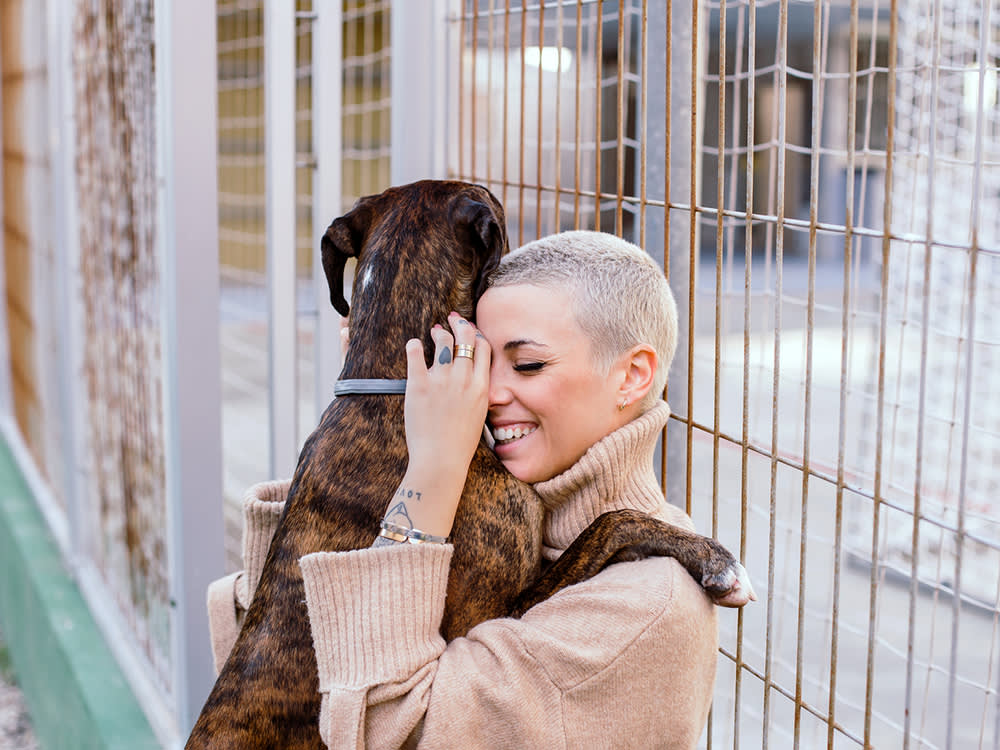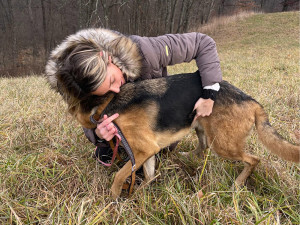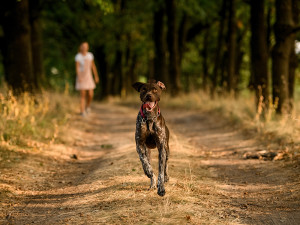Lost Pets: How to Get Them Back
Find out what to do when your pet goes missing with these tips from a pet recovery expert.

share article

Your pet wants you to read our newsletter. (Then give them a treat.)
There is no precise figure for the number of companion animals lost every year. But American Humane estimates that roughly 10 million pets are lost in the United States each year. Kat Albrecht, who founded Missing Animal Response in 2005, creates training partnerships with animal shelters so they can deploy volunteers to help pet parents recover lost pets. Volunteers help with local searches, including carrying out public alerts and deploying wildlife cameras and humane traps; they also provide sophisticated expertise, such as scent-detection search dogs and magnet dogs (more on that later). Albrecht shares important lessons from her decades spent finding lost dogsopens in a new tab and cats.
Use calming signals
A few days into a family vacation in faraway Bora Bora, Lynn Janata got an unwelcome email from her dog sitter in Renton, Wash.: “We have a situation here. Cali has gone missing.” The 14-month-old Australian Shepherd had bolted through an open garage door. Although the sitter took quick action, each time Cali was spotted, she was farther and farther from home.
With the help of friends in the Seattle area, Janata contacted Jim Branson, a volunteer with Missing Pet Partnership, a local group that helps recover lost animals. Branson’s black Labrador, Kelsy, is trained in scent detection for tracking other dogs. Several times, Branson and Kelsy found Cali’s scent, but they weren’t able to keep up. The dog crisscrossed a three-by-five-mile territory during her seven days on the lam.
When the family returned, they went directly from the airport to search for their dog. Janata headed to the intersection where Cali had last been sighted. And she saw her. “To me, it was a miracle — there she was, sleeping on somebody’s front porch,” she says. “But in the back of my mind, I’m hearing Jim say, She might even bolt from you.”
So Janata sat on the ground with her back to Cali and set out her favorite stuffed toy and treats. When Cali didn’t come forward, Janata lay on her back. That’s when the errant pup started sniffing the air. “Then she just broke into a run and jumped into my arms,” she says. “I started crying.”
Sitting with her back to Cali was hard for Janata. “I’m sure she wanted to run to her when she spotted Cali in that yard,” Branson says. “She may have wondered if my advice to lie on the pavement was the best way to catch a dog.”
He had been skeptical once himself. “I was like everyone else before I learned about this,” he says of the approach, which is based on calming signals developed by Turid Rugaas, a renowned Norwegian dog trainer. “Almost nobody knows about this before we tell them, and it’s everybody’s natural instinct, when they see a dog on the run, to chase it. That almost never works.”
How to find a lost pet
Recruit the help of friends, neighbors, and local community groups.
Search the general area they were last seen.
Don’t chase the pet if spotted (see lost pet recovery tips below).
Create lots of highly visible large print posters.
Tag your car window to generate leads.
Post your missing pet’s information to PetFBI and PawBoost.
Share your missing pet’s information on social media and local lost pet groups.
Have a friend check in with the animal shelter often.
Watch out for lost pet scams.
The best way to find a lost pet
Albrecht has spent years refining her techniques, and her biggest aha! moment is probably what she calls the intersection alert or intervention. An intersection alert is used to find lost pets by having volunteers hold neon-colored, poster-sized signs at a busy intersection near the pet’s escape point.
Take the case of a Chihuahua named Sukhi. Her frantic pet parents had five volunteers stake out the busiest intersection in Seattle’s Central District near Sukhi’s home, holding bright posters with Sukhi’s photo and CHIHUAHUA, RED COLLAR in large type. Within 20 minutes, someone driving through the intersection pulled over to say that Sukhi was at their house.
“The pet parents had put out hundreds of flyers prior to that, all of which had escaped the notice of this person, but these big signs are impossible to ignore, especially with someone there holding them,” Branson says. The “protest” creates a sense of urgency.
Intersection interventions are based on studies of “inattentional blindness,” which Albrecht read about in Temple Grandin’s book, Animals in Translation. “The hypothesis is that if you’re not paying attention to something, you won’t perceive it; it’s as if it’s not even there,” Albrecht says. The protests are designed to break through that blindness. (A related strategy is to tag a vehicle — providing the same key identifiers as on the posters — in neon ink on the back window.)
Even without staging protests, giant, bright, concise signs yield results — even weeks after old-fashioned 8-by-11 paper flyers have become rain-soaked, tattered and ineffective.
The approach for a missing dog is very different from that used to find a missing cat. Dogs runopens in a new tab. Cats hideopens in a new tab. To find a missing cat, you need a detailed search of your own and nearby properties. Wildlife cameras and humane traps are also helpful. To find a dog, “a search needs to be very visible,” Albrecht says. “Just massive, obnoxious marketing.”
When you spot a lost dog:
Use calming signals
Don’t chase the dog
Stay low
Sit down and speak in a calm manner
Try turning your back towards the dog to appear less threatening
If the dog is watching you, try lying down on the ground to get their attention
Or, try running away from the dog, so they follow
Sometimes, other dogs can help recover lost pups
Albrecht pioneered a technique for enticing reluctant pups: magnet dogs. The idea is to deploy a “wiggly, friendly dog” to attract a wary dog so they can be captured. It worked like a charm for a dog named Mack.
After escaping from their yard in Federal Way, Wash., Mack and his buddy Rocco, a pair of blue Pit Bullsopens in a new tab, went missing for almost a month. Their pet parent, who was serving overseas, was devastated. When volunteer Ryan Gamache learned about them, he made it his personal mission to recover the dogs.
Unfortunately, he discovered that Rocco had been killed and Mack had fled. But the bad news at least gave Gamache a starting point. He posted giant, neon posters that read “LOST BLUE PIT BULL BLUE COLLAR” along the major roadway near where Rocco had died. Immediately, leads came in, but the wary Pit Bull eluded capture for over a week.
New posters were added close to the last sighting. Leads flooded in the next morning. This time, Albrecht wasn’t willing to run the risk of losing Mack. She headed to the scene with her magnet dog, Kody, a super-friendly Whippet mix. Albrecht ended up just down the street from Mack, with Kody on a long leash.
“Mack immediately began to wag his tail, and walked right up to sniff noses with a tail-wiggling Kody,” Albrecht says. “My Snappy Snare was positioned over Kody’s nose so that when they sniffed noses, I could move it over Mack’s head, release the ring and catch Mack. It was a textbook capture!” It’s also an illustration of a central philosophy for recovering lost pets: try to think like the lost pet — in Mack’s case, like a dog who likes other dogs.
Persistence is key
When Branson lost his cat years ago, “We were told, as a lot of people are told today, ‘A coyote got your cat; there’s nothing you can do about it,’” he says. “It’s thinking like that that can prevent an animal from being found.” It takes persistence and encouragement to recover a pet. “Giving them encouragement [to look] increases the likelihood of a positive outcome,” says Branson.
Lost pet prevention tips
Don’t kid yourself that your well-adjusted pet would never bolt. There are always extreme circumstances — such as fires or intruders — that could prove you wrong. Seriously improve your pet’s odds by taking these proactive steps:
Always collar and tag and microchip your pet. A chip alone isn’t enough. Pets found without collars can be “adopted” by strangers who assume they’re strays.
If your dog is shy or skittish, add a tag with “I’m afraid, not abused” to their collar. Strangers may assume a cowering dogopens in a new tab has been mistreated and deliberately not return them.
Travel safely. Use a non-slip collar (such as a Martingaleopens in a new tab) to prevent your surprised or frightened dog from slipping free. In the car, crate your dog so they don’t escape if there’s an accident.
Have current photos of your pet. If your pet looks very different before and after grooming, have shots of each. See if your vet will attach a photo to your pet’s file in the event they escape during a house fire or flood in which your personal records are destroyed.
Be prepared. Create large, neon pet posters and keep them at hand to reduce delays if your pet disappears.
Have proof of ownership. There’s no guarantee that the person who finds your pet will give them back. A microchipopens in a new tab is the best proof of ownership.
Be neighborly. Introduce yourself and your pet to the neighbors; this makes it more likely they will let you know if they see your pet running loose. If your pet frequently roams, barks or annoys them, they may not be so quick to alert you to a sighting.
Secure your property. Make sure fences are high enough to keep in jumpers and deep enough to foil diggers, and keep an eye out for potential launching pads, such as lawn furniture.
Train your dog not to bolt through open gates and doors. Work through behavioral issues such as digging or not coming when called.
Collect and store scent and DNA. Should you need to hire a pet-detection dog, a distinct scent sample from your missing pet is essential, especially if you have more than one animal in your home. (Ideally, you’ll never need it.) Wearing sterile gloves, wipe a gauze pad over your dog’s back, belly and mouth. Store in a zip-type bag in the freezer. A few plucked hairs (including the root) and nail clippings stored in another bag can be useful in the unfortunate event remains are found. The Veterinary Genetics Laboratory opens in a new tabat UC Davis can test the DNA and tell you if it’s from your pet.

Lisa Wogan
Lisa Wogan lives in Seattle and is the author of several books including Dog Park Wisdom.
Related articles
![Golden retriever running around a local park during sunset]() opens in a new tab
opens in a new tabThe Macro Benefits of Microchipping Your Dog
Sure, microchips can feel a little 1984. But if your pup has a chip, they’re four times more likely to make it home if they get lost.
![Brown dog with merle coat running towards the camera on a forest path with a woman standing in the fall distance calling out to him]() opens in a new tab
opens in a new tab“How Do I Get My Dog to Come When Called?”
The Wildest Collective dog trainer Robert Haussmann’s tips for getting a stubborn pup to listen up.
![Woman in vintage striped pants walking in park while her pet is following the trail. Cute beagle dog sniffs something on the path in morning.]() opens in a new tab
opens in a new tabDoes Your Dog Have a Nose For Scent Training?
This sounds like a competition show waiting to happen.
![Two dogs acting rowdy at the lake while a person tries to calm them down]() opens in a new tab
opens in a new tabMy Dog Is Misbehaving. What Should I Do?
Don’t blame the dog — instead, figure out how to help them succeed.





